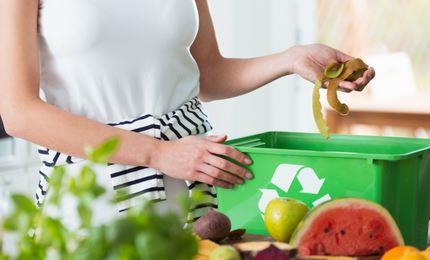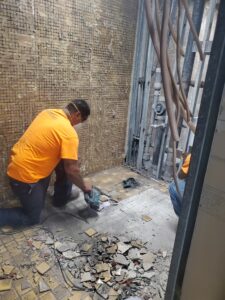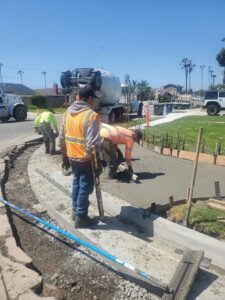Article written by guest author and local resident, Erika Kotite
The year 2022 marks a significant change in how we residents of California and Huntington Beach can manage our organic waste. Thanks to SB 1383, California’s landmark organics law, we will now have the opportunity to divert as much as 22% of our garbage from landfills to composting and other conversion facilities. How? By separating all food waste into a separate container and depositing it for pickup in standard green yard waste bins every week.
CalRecycle, which is the nickname for the California Department of Resource Recycling and Recovery, generated a lot of buzz when they began promoting their new law last December. The announcement created a lot of interest and even more confusion for residents because no one was sure what they were supposed to do, or when.
I am a Huntington Beach resident who is very interested in better waste management and was ready to do my part. A couple of years ago I bought a countertop metal scrap container and some compostable bags. I also bought a backyard compost tumbler, shaped like a cylinder, that you turn every couple of days to mix the compost.
When SB 1383 was widely announced on January 1, I jumped right in. Since we don’t currently have a green waste container, I asked my neighbor if I could deposit my food scraps (the stuff that was too big for my backyard composting efforts) into hers. I was a little too enthusiastic; the implementation in our city is still a number of months away (Huntington Beach expects to have full launch by Fall 2022). Fortunately, I kept the scraps in a plastic garbage bag and was able to pull them out.
The following is some basic information about the new program, what will happen next, and most importantly, how we can prepare ourselves for full participation.
What Is SB 1383?
SB 1383, made into law in the state of California in 2016, is an environmental initiative that focuses on what are called “short-lived climate pollutants”: specifically, refuse that emits methane gas as it decomposes. Methane gas is produced by many things, including dairy and livestock operations (cow manure is a huge contributor), waste management facilities, and landfills. In landfills, it is the organic waste, i.e. foods and food by-products that creates the highest levels of methane as they decompose.
These pollutants are called “short-lived” but they are very potent. Methane gas lasts about 12 years in the atmosphere (versus 100 years for CO2) but it is 86 times more powerful than CO2 over a 20-year period. Goals of the program are impressive: a 75% reduction in statewide disposal of organic waste from 2014 levels by 2025.
SB 1383 requires all municipalities in the state of California to offer organic waste disposal programs. Each city or municipality contracts with its selected waste management company to provide the elements of the program including appropriate waste containers, identifying where and how the waste is sorted and processed, and budgeting the program with appropriate rate increases to cover the cost.
Where We Are Now
Although the program officially began on January 1, it will take most of the year for residents to see a change in their garbage collection. Right now, the City and Republic Services, our waste management company, are working out the many details as mentioned in the previous paragraph. Keep in mind this is the biggest curbside initiative we’ve had in decades, since blue recycle bins were introduced in the late 1990s.
Bottom line: All California programs must be in place before the end of the year. The City of Huntington Beach estimates that residents can begin to put their organic scraps out for pickup by the second half of the year.
Ideally, household organic waste will end up in one of two homes: either in backyard composting bins or in a separate container to be picked up along with yard waste by Republic Services, who will ship it to commercial composting operations to turn into soil amendment and fertilizer.
The City and Republic Services will be providing plenty of education and information to help residents learn how to identify organic waste, easy ways to sort it, and how to keep it from messing up our kitchens and garbage bins. There will be different methods for collecting the waste, depending on whether you live in a single-family home or in multi-family homes such as condos and apartments.
How to Get Ready
Although curbside pickup is still months away, there are a number of things we can do to get ready. The biggest challenge with isolating food waste is that it cannot be contained and dumped in typical trash bags. We need to devise a practical system of containment and disposal that will be mess-free, not smelly, and doesn’t attract unwanted pests. Here are some steps you should consider taking now, which will get you in prime condition for the big leap!
In-house scrap management: For now, start thinking about where and how you will collect and keep food scraps separate from other trash and recyclables so that they can be tossed in the organics container. One way to manage food scraps is to set aside all of your meal prep and cleanup in a bowl and take it out to the organics cart after each meal. Another method is to use a small container with a lid to hold food scraps for up to a few days until you can empty into the organics cart. Ideally, this is small enough to fit under the sink or on the kitchen counter so it is easy to grab while prepping and cleaning up meals. A third method is to collect scraps in a reusable bag or container and store in the fridge or freezer, then dump the contents in the green bin on trash day. Every household is unique, so you might have to experiment to figure out what works for you. Right now, the only way to dump the waste is into a backyard composting pile or into the regular trash bin. However, if you have the budget, there are some cool new electric countertop composters that turn your scraps into soil within hours. Check out Tero and Lomi for more information.
Outdoor scrap management: If you have the space and are itching to get started right away, try composting at home. The City and Shipley Nature Center offer seminars with the basics of composting, and attendees get a voucher towards the purchase of a home compost unit. There are many small composting bins on the market such as this one and this one. Dump your countertop pail into it and then add dry materials from your yardwork to keep a balance. (I am pretty loose with my balance and it works fine.) Remember that to avoid odors and pests, some foods are not suitable for backyard composting (think meat, bones, dairy). Many of us have small backyards or even no backyards. That’s why I’m excited about CalRecycle’s Community Composting Program. Since many of us live in planned communities, perhaps we can work with our HOAs to use community compost in the landscaping.
Curbside scrap management: When it comes time for the big rollout, most of us will simply push our existing green carts out the curb with food scraps now included with our regular yard waste. Republic Services will be delivering a green container to all the households that don’t currently have one. Food scraps will go in there, and then simply push it to the curb or alley with your trash and recycling containers on trash day. Apartment dwellers with shared dumpsters will see changes in their trash areas, too – a new green container for food and plants, plus a recycle bin for paper, cardboard and other recyclables.
Check Surf City Break, your other favorite local news sites, and CalRecycle’s website regularly to get the latest on this exciting way we all can make a huge difference in reducing pollution.
Examples of Organic Waste
Check out the last item on this list – it is probably my favorite, since so many of us go through a lot of takeout waste.
- Coffee grounds, paper coffee filters, and compostable tea bags
- Yard waste
- All fruits and vegetables, peels, core and all (including citrus and onions)
- All plant waste
- Meat and meat bones
- Fish and fish bones
- Bread and grain products
- Eggshells
- Dairy products (cheese and butter)
- Cooked food and leftovers, spoiled food
- Food-soiled napkins, paper towels, and tissues
About the Author: Erika Kotite has been a resident of the Brightwater community since 2011. She is the author of several books about she sheds and co-founder of She Shed Living, a company that helps women find their own beautiful space in the backyard.








